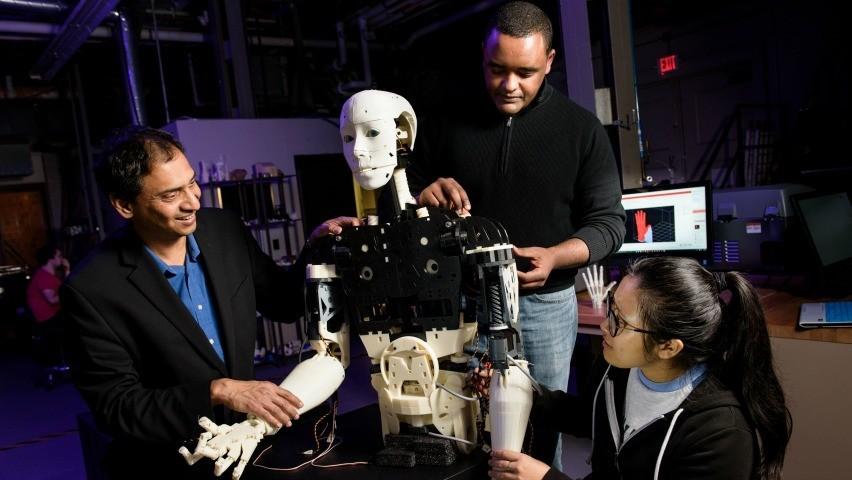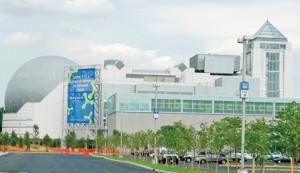From now through the month of May, the Liberty Science Center in Jersey City, New Jersey, will have a special guest taking selfies and playing “Simon Says” with visitors, courtesy of the Hoboken-based Stevens Institute of Technology. After hosting a successful exhibition featuring four Senior Design projects by students of the university back in Spring of 2015, the LSC recently approached the school about 3D printing an interactive and educational robot for a new exhibition. Together, they settled on 3D printing the open sourced InMoov robot project created by French designer and sculptor Gael Langevin, and created what could be the fastest 3D printed full-upper-torso robot ever.
In order to prepare the robot for printing, the Stevens team transformed a SolidWorks software model of Langevin’s design into STL files. Utilizing two 3D printers from the university’s new PROtotype Object Fabrication (PROOF) Lab, students from a graduate additive manufacturing course, taught by research engineer Biruk Gebre, 3D printed each part from scratch. Made up of approximately 100 components—including limbs, joints, and bones—the robot was printed in a polyvinyl chloride (PVC) plastic material. In total, the PROOF lab houses eight 3D printers, one of which is an Objet model from Stratasys.
“This is probably is the fastest-produced full upper-torso 3D-printed robot anywhere in the world right now,” said Pochiraju.
 After each part was printed from scratch, Stevens’ fifth-year mechanical engineering major Peter Bruinooge put the robot together piece by piece. Prior to this project, Bruinooge had utilized 3D printing technology to help manufacture infant products, and also helped the Department of Defense to redesign a body-armor suit. Bruinooge worked with Gebre and a team of computer and electrical engineering students to help wire up, power, and program the robot with motors, servos, and an Arduino control module, which enables the 3D printed robot to move its body, wiggle its fingers, take a selfie, play “Simon Says” (and tell you if you lose), and can even talk to you about how it was built.
After each part was printed from scratch, Stevens’ fifth-year mechanical engineering major Peter Bruinooge put the robot together piece by piece. Prior to this project, Bruinooge had utilized 3D printing technology to help manufacture infant products, and also helped the Department of Defense to redesign a body-armor suit. Bruinooge worked with Gebre and a team of computer and electrical engineering students to help wire up, power, and program the robot with motors, servos, and an Arduino control module, which enables the 3D printed robot to move its body, wiggle its fingers, take a selfie, play “Simon Says” (and tell you if you lose), and can even talk to you about how it was built.

PROOF Lab Director Kishore Pochiraju, lab engineer Biruk Gebre (center) and graduate student Yuchi Chen (right) operate the 3D printed robot
Langevin’s InMoov robot design has been used on numerous occasions, oftentimes for humanitarian efforts. For instance, the Robots for Good project has utilized the InMoov design to help hospitalized children. Last year, Robots for Good 3D printed an InMoov Explorer to take patients from the Great Ormond Street Children’s Hospital on a virtual visit of the London Zoo. The InMoov robot design has also been popularized by Wevolver, the leading platform for open source hardware projects.
Prior to the robot exhibit, which started on April 19, the Liberty Science Center featured the work of four student teams from Stevens, including a mobile robot, model-scale trains, an Iron Man-like body armor suit, and an open sourced electric guitar. Though the Stevens Institute of Technology’s InMoov robot may not be engineered for a social purpose, the 3D printed robot stands to inspire the mass amounts of middle and high schoolers who frequently visit the Liberty Science Center. For Bryan Blaney, the director of guest engagement at the Jersey City-based science museum, this is the most exciting prospect of this quickly built and playful 3D printed robot exhibition.
“The Science Center is always interested to partner in ways that showcase cutting-edge tech for our guests; these are the technologies that are shaping our world,” said Blaney. “What was particularly exciting about Stevens students working directly with our guests, apart from the technology, is that our guests — many of whom are middle- and high school students — can see people not much older than they are doing amazing work.”
What are your thoughts on this particular student project? Discuss in the 3D Printed Robot forum over at 3DPB.com.
[Source/Images: Stevens Institute of Technology and Hoboken Patch]Subscribe to Our Email Newsletter
Stay up-to-date on all the latest news from the 3D printing industry and receive information and offers from third party vendors.
You May Also Like
3D Printing News Unpeeled: A $3000 SLS System, Construction Subsidies and Parameters
The Housing Affordability Crisis is one of Canadian President Trudeau’s biggest issues. Now the government has made subsidies available, including scaling new technologies, 3D printed housing and libraries of reapproved...
“Bundled Light” Enables High Quality Plastic 3D Printing from LEAM
Naturally, we expect current 3D printing methods to continuously improve, but it continues to do so in the most surprising ways. The latest development comes from LEAM, a startup spun...
Each to Their Own: Exploring Creality’s Latest Ender Trio as the Company Strengthens Its Commitment to 3D Printing Advocacy
Creality has reaffirmed its commitment to promoting 3D printing. The launch of the Ender-3 V3 SE, Ender-3 V3 KE, and Ender-3 V3 showcases the company’s dedication to catering to diverse...
3D Printing News Briefs, March 23, 2024: AM in the US Coast Guard, Navy, & More
In today’s 3D Printing News Briefs, we’re discussing the use of 3D printing in various branches of the military, including the U.S. Coast Guard, the U.S. Navy, and the German...

































